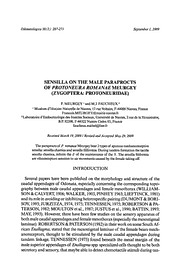
Sensilla on the male paraprocts of Protoneura romanae Meurgey (Zygoptera: Protoneuridae) PDF
Preview Sensilla on the male paraprocts of Protoneura romanae Meurgey (Zygoptera: Protoneuridae)
Odonatologica38(3):267-271 SeptemberI,2009 Sensilla onthemaleparaprocts ofProtoneura romanaeMeurgey (Zygoptera: Protoneuridae) F. Meurgey¹and M.J.Faucheux² 1Museumd’Histoire NaturelledeNantes, 12rueVoltaire,F-44000 Nantes,France [email protected] 2Laboratoire d’Endocrinologiedes InsectesSociaux, Universite deNantes,2ruedelaHoussiniere, B.R92208,F-44322 NantesCedex03,France [email protected] ReceivedMarch 19,2009/Revised andAcceptedMay29, 2009 TheparaproctsofP. romanaeMeurgeybear2typesofaporousmechanoreceptive sensilla: sensilla chaetica andsensillafiliformia. Duringtandemformationthe tactile sensilla chaetica,inform the 6 ofthemaintenance ofthe $.The sensilla filiformia arevibroreceptorssensitivetoairmovementscausedbythefemaletakingoff. INTRODUCTION Several papershave beenpublished on themorphology and structure ofthe caudalappendages ofOdonata, especially concerning thecorresponding topo- graphy betweenmalecaudalappendages and femalemesothorax(WILLIAM- SON&CALVERT, 1906;WALKER, 1903,PINHEY 1963;LIEFTINCK,1981) anditsroleinavoiding orinhibitingheterospecific pairing(DUMONT &BORI- SOV, 1993;JURZITZA, 1974,1975;TENNESSEN, 1975;ROBERTSON &PA- TERSON, 1982;MOULTON etal., 1987; JUSTUSetal., 1990;BATTIN, 1993; MAY, 1993). However, there havebeenfewstudies onthe sensoryapparatusof bothmalecaudalappendages andfemalemesothorax(especially themesostigmal laminae). ROBERTSON& PATERSON (1982)intheirwork on someSouthAf- ricanEnallagma, statedthatthemesostigmal laminaeofthefemalebearsmech- anoreceptors, thought to be stimulated by themale caudal appendages during tandemlinkage. TENNESSEN (1975) foundbeneath the mesalmargin of the malesuperiorappendages ofEnallagmaspp.specialized cells thought tobeboth secretoryandsensory, thatmaybeabletodetectchemotactilestimuliduringtan- 268 F.Meurgey&M.J.Faucheux demlinkage, and enablefemalesgrasped by a maleto takeavoiding action and prevent heterospecifictandemsfromforming. Besidesfacilitating species recog- nition, the apposition of maleandfemales structures may create achannelof sensory communication. Thepresent work on thefine structureofthe sensilla of themale caudalap- pendages ofProtoneuraromanaeMeurgeywascarriedouttoaidourunderstand- ing ofthesensory basisofodonatebehaviour. MATERIALANDMETHODS TheadultmalesweretakenfromasmallstreamatSofai'a, Basse-Terre,Guadeloupe(FWI)on1st February2006.Forstudywiththescanningelectronmicroscopy(SEM),thesuperiorcaudalappend- ages oftwomales weredehydratedin absolute ethanol,mounted onspecimenholders,andcoated with athin layerofgoldand palladiuminaJFC 1 100sputtercoaler.Preparationswereexamined with aJeol JSM6400 SEM atdifferentmagnifications.TheterminologyofZACHARUK (1985)is used innamingthetypes ofsensilla. RESULTS TwotypesofsensillawerefoundontheparaproctsofP.romanae;aporoussen- sillachaetica and aporous sensilla filiformiawitha characteristicarrangement (Fig. 1).Theaporoussensillachaeticaare principally locatedontheinternalface ofeachparaproct, withfewonthedorsalface.Thereare40withalengthreach- ing 60pm andabasal diameterreaching 2.5pm.They taketheformofafrayed stiffhair,eachinsertedinacupolareaching 7.5pmdiameterand7.5pminlength (Fig. 2). Theaporoussensilla filiformia are located principally on the externalface of each paraproct. They takethe formofathinhair, witha basal diameterof 1.3 pm,flexibleandlongitudinally striated. Thereare 20, varyinginlength between 26 pmand 70pm(Fig. 3). Theyare eachinserted onadomemeasuring 5.5pm in diameter,withanopening whichnarrowlyenclosethebaseofthesensilla(Fig. 4).Thedomeitselfis maintainedby cuticular spansat thebottomofabroader cavity of7.8pmdiameter(Fig. 5). DISCUSSION Aporous sensillachaeticaare tactilereceptors, stimulatedby the femalemes- ostigmallaminaeduringtandemlinkage. Already observedonthefemaleprotho- rax of someCoenagrionidae (ROBERTSON &PATERSON, 1982), theirpres- enceonthesuperior caudalappendages ofthemaleProtoneuraromanaesuggest thatboth maleand femaleare ableto recognize and thenavoid heterospecific pairing. Sensilla chaeticamayalso play animportant role during tandemflight inmaintaining malegrip onthefemaleprothorax. Sensilla onparaproctsofProloneuraromanae 269 Sensillafiliformiaare foundontheabdominalappendages ofterrestrialinsects belonging todifferentorders(GNATZY, 1976;GNATZY& SCHMIDT, 1971), and ontheantennae andcaudalappendages ofodonatalarvae(MEURGEY& FAUCHEUX, 2006a,2006b;FAUCHEUX, 2007). On thesuperior caudalap- pendages ofallinsects, thearticulationofthe sensillawiththetegumentis clas- sified according to threetypes(FAUCHEUX, 2002). Thebasalstructureofthe sensilla inP. romanae belongs to types 1 and3. As intype 1 (Acheta sp„ Gryllus sp„ Thermobiadomestica, Monotylota ramburi) thesensilla, insertedin abroad cup, hasits displacements limitedby theedges ofthe cup itself. However, as in type 3 (cockroaches, Dermaptera), the displacement of the sensilla is possible only becauseofitsinsertion, insidethe dome, viaa deformablearticularmem- brane allowing variousslopes (GNATZY, 1976). Whenlocated on the cerci of non-flying insects(cerci ofcockroaches, embi- ids, earwigs), sensillafiliformiareact toair displacements caused by apredator, Figs1-5.DetailsofparaproctofProtoneuraroma- nae:(1)malerightparaproct,viewedfrombehind showingthesensilla chaetica(C), andsensillafili- formia(F);- (2)basalregionofasensillumcha- eticumshowingcupola(CU); - (3)shortsensilla filiformia(F);- (4)baseofsensillumfiliformium showingthedome(D)atthebaseofthesensillum; - (5)detailoftheinside ofthecupola(CU)ofa sensillum filiformium(sensillumomitted),show- ingcuticular spans(CS). 270 F.Meurgey&M.J.Faucheux andinvolvethe escapebehaviour. This isespecially wellstudied incockroaches (PUMPHREY & RAWDON-SMITH, 1937;ROEDER, 1948). Inflying insects, abdominalsensillafiliformiahaveonly been describedon the malegenitalia ofthe primitivemicrolepidopteran Apoplania valdivianaDavis& Nielsen(Neopseustidae) (FAUCHEUX, 1999,2005) andon thesuperior caudal appendages ofP. romanae. Thepresence of sensilla filiformia on the paraproctsof P. romanae suggests that, as in otherinsects, they are stimulatedby air displacements andcouldre- place visionfrombehind, allowing theavoidanceof directpredation by reacting to airmovements, dueto predator approach. Fieldobservationofreproductive behaviourledus to considerthatthesensilla filiformia mayalso havearoledur- ing tandemoviposition. TRAPERO QUINTANA etal.(2005) intheirstudy on thereproductive behaviourofP.capillaris,statedthatseveralfactorscouldinter- ruptoviposition, suchaswindorwatermovements duetoaquaticinsects. Aquatic insects such as Heteroptera are consideredto be direct predators, andtheirap- proach inducesescapebehaviourinodonates. BothP. capillaris and P. romanae inserttheireggsinunstablesupports such as deadleaves,woodsticks andothers floating debris. Thewindgenerallyincreases theinstability ofthe supportitself, andmayinitiateescapebehaviour. Weobservedseveraltandempairs ofProtoneuraromanaeduringflightandovi- position,andnoticedthatthefemaleleadsthetandempair inflightandtakesoff first fromtheoviposition support.Thissuggests thatthesensillafiliformiaonthe externalsideofthemalesuperior caudalappendages mayalsoplay aroleduring tandemoviposition and react to air displacement dueto thefemaletaking off, allowing synchronisation of theseparation ofthepair. ACKNOWLEDGEMENTS We wish toacknowledgePIERRE WATELET,Director ofthe MuseumofNatural History of Nantes, FranceforfacilitatingtheuseoftheSEM and ALAIN BARREAU, CentreofSEM,Uni- versityofNantes,France,fortechnical assistance. REFERENCES BATTIN, T.J., 1993. The odonate matingsystem, communication,and sexual selection: a review. Boll. Zool. 60: 353-360. DUMONT,H.J.&S.N.BORISOV,1993. Three,nottwospeciesinthegenusSympecma(Odonata: Lestidae). Bull. AmisSoc. r.beigeEnt. 129:31-40. FAUCHEUX,M.J., 1999. Biodiversite elunitedes organessensoriels des insecteslepidopteres.Soc. Sci.Nat. QuestFr.,Nantes. FAUCHEUX,M.J., 2002.Lamarcheareunions de1’EmbiedeRambur,Monotylotaramburi Rims- ky-Korsakow(Insecta:Embioptera:Oligotomidae).Lesimplicationssensoriellesdescerques etdes antennes.Bull. Soc. Sci.not.QuestFr. (N.S.)24:35-52. FAUCHEUX,M.J., 2005.Sensilles filiformes enregistrantles emplacementsd’airetlesvibrations so- Sensilla onparaprocts ofProtoneura romanae 271 noressurlesgenitaliamalesd’Apoplaniavaldiviana (Lepidoptera:Neopseustidae).Bull. Soc. Sci.nat. QuestFr.(N.S.)27:p. 121. FAUCHEUX, M.J.,2007.Sensilla andcuticular structuresonthelarvalcaudalappendagesofEryth- romma lindenii (Selys, 1840)(Odonata:Zygoptera:Coenagrionidae).Bull. Inst.r. Sci.nat. Belg. Ent.77: 113-119. GNATZY,W, 1976. TheultrastructureofthethreadhairsonthecerciofthecockroachPeriplaneta americana L.:theintermoultphase.J Ultrastrucl. Res. 54: 124-134. GNATZY, W.&K. SCHMIDT, 1971. Die FeinstrukturderSinneshaare aufdenCercivonGryllus bimaculatus Deg.(Saltatoria,Gryllidae).1.Fadenund Keulenhaare. Z. Zellf.122: 190-209. JURZITZA,G.,1974, Rasterelktronenmikroskopische UntersuchungendesZangengritTesund der Laminae mesostigmaleseinigerCoenagrionidae(Odonata:Zygoptera).FormaetFunctio7: 377-392. JURZITZA,G., 1975.Rasterelektronenmikroskopische Untersuchungenanden Appendicesund denLaminaemesostigmaleseinigerEnallagma-Arten(Odonata:Zygoptera).FormaelFunc- tio8;33-48. JUSTUSB.G., S.E.TRAUTH& G.L. HARP, 1990, Themesostigmal complexofsix Argiaspe- cies using scanningelectron microscopy (Zygoptera:Coenagrionidae).Odonatologica 19: 145-152. LIEFTINCK, M.E., 1981. Some little known speciesofRisiocnemis CowleyfromthePhilippines Islands,with notes ontheir synonymy, morphologicalcharacters and larval structure(Zy- goptera:Platycnemididae).Odonatologica10:93-107. MAY,M.L., 1993. UnderstandingthetaxonomicsignificanceofthemalecaudalappendagesofZy- goptera- thecaseofEnallagma.Abstr.I2'iInt. Symp.Odonatoi,Osaka,p. 23. MEURGEY,E, 2006. Protoneuraromanaespec. nov.from Guadeloupe,French WestIndies.(Zy- goptera:Protoneuridae).Odonatologica35(4):369-373. MEURGEY, F.& M.J.FAUCHEUX, 2006a. Vibroreceptors andproprioceptorsonthelarval an- tennaeof Erythrommalindenii (Selys, 1840)(Zygoptera: Coenagrionidae).Odonatologica 35(3):255-264. MEURGEY,F.& M.J.FAUCHEUX,2006b.Organessensoriels des antennesde lalarvede Chalco- lestesviridis (VanderLinden,1825)(Odonata,Zygoptera,Lestidae). Martinia 22:167-171. MOULTON,S.R.,S.E. TRAUTH& G.L.HARP, 1987. The mesostigmalcomplexofArgiausing scanningelectronmicroscopy (Zygoptera:Coenagrionidae),Odonatologica16:285-289. PINHEY,E.,1963.NotesonbothsexesofsometropicalspeciesofCeriagrionSelys(Odonata).Ann. Mag. nat. Hist. 13(6): 17-28. PUMPHREYR.J.,& A.E RAWDON-SMITH, 1937.Synaptic transmission ofnervousimpulses throughthe last abdominal ganglionof the cockroach. Proc. R. Soc. Land. (B) 122: 106- 118. ROBERTSON, H.M.& H.E.H.PATERSON, 1982. Materecognitionand mechanical isolation in Enallagmadamselflies(Odonata:Coenagrionidae).Evolution 36: 243-250. ROEDER K.D., 1948.Organizationoftheascendinggiantfibersystem inthecockroach(Periplan- etaamericana).J.exp. Zool. 108:243-261. TENNESSEN,K.J., 1975. Reproductivebehavior andisolationoftwosympatriccoenagrioniddam- selfliesinFlorida.PhDthesis,Univ. Florida,Gainesville. TRAPERO QUINTANA, A.D.,Y,TORRESCAMBAS&E.GONZALESSORIANO, 2005.Es- tudiodel comportamientodeoviposiciondeProtoneuracapillaris(Rambur,1842)(Odonata: Protoneuridae).Foliaent.mex. 44; 225-231, WALKER,E.M.,1903.MutualadaptationofthesexesinArgiamoestaputrida.Can.Ent.45:143-148. WILLIAMSON,E.B.& CALVERTP.P., 1906.CopulationofOdonata.l. Ent. News 17: 143-148. ZACHARUK, R.Y., 1985. Antennae andsensilla. hr.G.A.Kerkut& L.I.Gilbert,[Eds],Compre- hensive insectphysiology,biochemistryandpharmacology,Vol. 6,pp. 1-70,PergamonPress, London.
